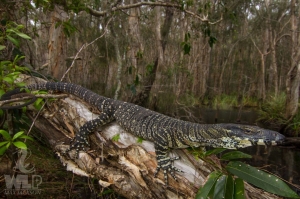Significance to Humans:
With long claws and very sharp teeth they should be treated with caution. Bites may cause substantial lacerations.
General description:
Large, heavy bodied lizard with a Long slender tail which is laterally compressed with broad bands on the lower portion of the tail. Chin is usually banded, body dark grey to dyll bluish black in colour with numerous scattered cream spots forming spotted or solid bands.
Average length:
Around 2.1 metres but large specimens may exceed 3 meters.
Habitat in SE Qld:
Prefers well-timbered areas and are common in most forest and woodland vegetation types.
General habits:
Most commonly encountered monitor lizard (Goanna) within the region. Active, wide forager by day. Frequently becoming habituated (used to humans) near picnic and camping grounds looking for an easy meal. Arboreal and ascends trees when disturbed.
Diet:
Active Foragers. Carnivorous feeding on vertebrates, invertebrates and larvae, including fish, frogs, eggs, lizards, snakes, birds and other small mammals, also Carrion (deceased animals).
Local distribution:
The Lace Monitor is widespread throughout South East Queensland occurring in suburban backyards in close proximity to forested areas.
Around the home:
Has been known to shelter in roof cavities of homes. Commonly encountered raiding chicken coops and farms for poultry and eggs.

